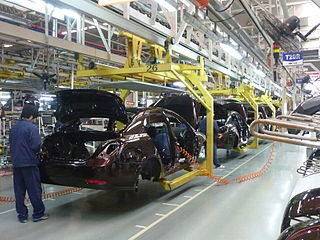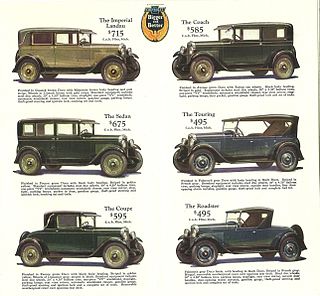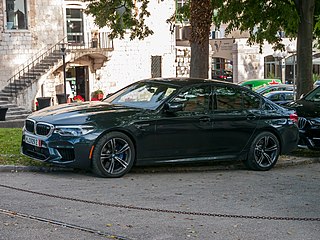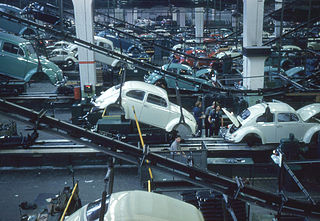 W
WThe automotive industry comprises a wide range of companies and organizations involved in the design, development, manufacturing, marketing, and selling of motor vehicles. It is one of the world's largest industries by revenue. The automotive industry does not include industries dedicated to the maintenance of automobiles following delivery to the end-user, such as automobile repair shops and motor fuel filling stations.
 W
WThe 2009–11 Toyota vehicle recalls involved three separate but related recalls of automobiles by Toyota Motor Corporation, which occurred at the end of 2009 and start of 2010. Toyota initiated the recalls, the first two with the assistance of the U.S. National Highway Traffic Safety Administration (NHTSA), after reports that several vehicles experienced unintended acceleration. The first recall, on November 2, 2009, was to correct a possible incursion of an incorrect or out-of-place front driver's side floor mat into the foot pedal well, which can cause pedal entrapment. The second recall, on January 21, 2010, was begun after some crashes were shown not to have been caused by floor mat incursion. This latter defect was identified as a possible mechanical sticking of the accelerator pedal causing unintended acceleration, referred to as Sticking Accelerator Pedal by Toyota. The original action was initiated by Toyota in their Defect Information Report, dated October 5, 2009, amended January 27, 2010. Following the floor mat and accelerator pedal recalls, Toyota also issued a separate recall for hybrid anti-lock brake software in February 2010.
 W
WAn ageing suit is a suit pioneered by the automotive industry in simulating the constraints of older aged drivers. Ageing suits were first used by Japanese car-maker Nissan in the early 21st Century, since Japan has a large aged population. MIT's ageing suit, nicknamed "AGNES", has been used in research by companies such as Siemens, Daimler and General Mills. The suits target and enable the study and solving of such senior citizenry infirmities as bad balance, stiff joints, weaker eyesight and extra weight. According to Nissan's associate chief designer Etsuhiro Watanabe; "Difficulty in walking, back pains, trouble in lifting arms -- we wanted to consider assorted infirmities. It's easy to do this for the young, but we wanted to design for adverse conditions and see what modifications are needed."
 W
WArgo AI is an autonomous driving technology company headquartered in Pittsburgh, Pennsylvania. The company was co-founded in 2016 by Bryan Salesky and Peter Rander, veterans of the Google and Uber automated driving programs. Argo AI is an independent company that builds the software, hardware, maps, and cloud-support infrastructure to power self-driving vehicles. Argo has two major investors: Ford Motor Co. (2017) and the Volkswagen Group (2020). Argo’s Self Driving System (SDS) technology will be incorporated into vehicles manufactured by the auto-makers through these partnerships.
 W
WAn autorack, also known as an auto carrier, is a specialized piece of railroad rolling stock used to transport automobiles and light trucks. Autoracks are used to transport new vehicles from factories to automotive distributors, and to transport passengers' vehicles in car shuttles and motorail services, such as Amtrak's Auto Train route.
 W
WA car carrier trailer, also known as a car-carrying trailer, car hauler, or auto transport trailer, is a type of trailer or semi-trailer designed to efficiently transport passenger vehicles via truck.
 W
WThe most popular car colours as of 2012 were greyscale colours, with over 70% of cars produced globally being white, black, grey or silver. Red, blue and brown/beige cars ranged between 6% and 10% each, while all other colours amounted to less than 5%.
 W
WThe model of a car is the name used by a manufacturer to market a range of similar cars. The methods used by car manufacturers to categorise their product range into models varies between manufacturers.
 W
WA development mule in the automotive industry is a testbed vehicle equipped with prototype components requiring evaluation. They are often camouflaged to deceive competitors and thwart a curious automotive press.
 W
WThe ENX Association is an association of European vehicle manufacturers, suppliers and organisations.
 W
WEuropean delivery programs are arrangements that continental European automobile manufacturers make with their dealerships throughout the world, to attract consumers who will combine the purchase of a European-made automobile with a trip to Europe. These are typically aimed at the North American market, which constitutes the most profitable market for Audi, Mercedes-Benz, BMW, Volvo and Porsche.
 W
WThe Fédération Internationale des Sociétés d'Ingénieurs des Techniques de l'Automobile (FISITA) is the international federation that brings together the global automotive mobility sector to share ideas and advance automotive technological development
 W
WDiesel engines began to be used in automobiles in the 1930s. Mainly used for commercial applications early on, they did not gain popularity for passenger travel until their development in Europe in the 1950s. After reaching a peak in popularity worldwide around 2015, in the aftermath of Dieselgate, the diesel car rapidly fell out of favor with consumers and regulators.
 W
WThis is a list of manufacturers by motor vehicle production, by year, based on Organisation Internationale des Constructeurs d'Automobiles (OICA).
 W
WThe OPEN Alliance is a non-profit, special interest group (SIG) of mainly automotive industry and technology providers collaborating to encourage wide scale adoption of Ethernet-based communication as the standard in automotive networking applications.
 W
WPonton or pontoon styling is an automotive design genre that spanned roughly from the 1930s-1960s, when pontoon-like bodywork enclosed the full width and uninterrupted length of a car body — eliminating previously distinct running boards and articulated fenders. The fenders of an automobile with ponton styling may also be called Pontoon fenders, and the overall trend may also be known as envelope styling.
 W
WPre-production cars are vehicles that allow the automaker to find problems before a new model goes on sale to the public. Pre-production cars come after prototypes, or development mules which themselves are preceded by concept cars. Pre-production vehicles are followed by production vehicles in the mass production of them for distribution through car dealerships.
 W
WThe characteristics of a production vehicle or production car are mass-produced identical models, offered for sale to the public, and able to be legally driven on public roads. Legislation and other rules further define the production vehicle within particular countries or uses. There is no single fixed global definition of the term.
 W
WRebadging in the automotive industry is a form of market segmentation used by automobile manufacturers around the world. To allow for product differentiation without designing or engineering a new model or brand, a manufacturer creates a distinct automobile by applying a new badge or trademark to an existing product line.
 W
WSpecialty Equipment Market Association (SEMA) of the automobile aftermarket was formed in 1963 by Roy Richter, Ed Iskenderian, Els Lohn, Willie Garner, Bob Hedman, Robert E. Wyman, John Bartlett, Phil Weiand Jr, Al Segal, Dean Moon, and Vic Edelbrock Jr. and now consists of 6,383 companies worldwide, bringing together aftermarket manufacturers, original equipment manufacturers (OEM), media, car dealers, specialty equipment distributors, installers, retailers and restoration specialists.
 W
WSpot delivery is a term used in the automobile industry that means delivering a vehicle to a buyer prior to financing on the vehicle being completed. Spot delivery is used by dealerships on the weekend or after bank hours to be able to deliver a vehicle when a final approval cannot be received from a bank. This method of delivery is regulated by many states in the U.S., and is sometimes referred to as a "Yo-Yo sale" or "Yo-Yo Financing."
 W
WThe Transparent Prototype is a project in the automotive industry to track and trace test vehicles and prototype parts using Radio Frequency Identification (RFID) technology.